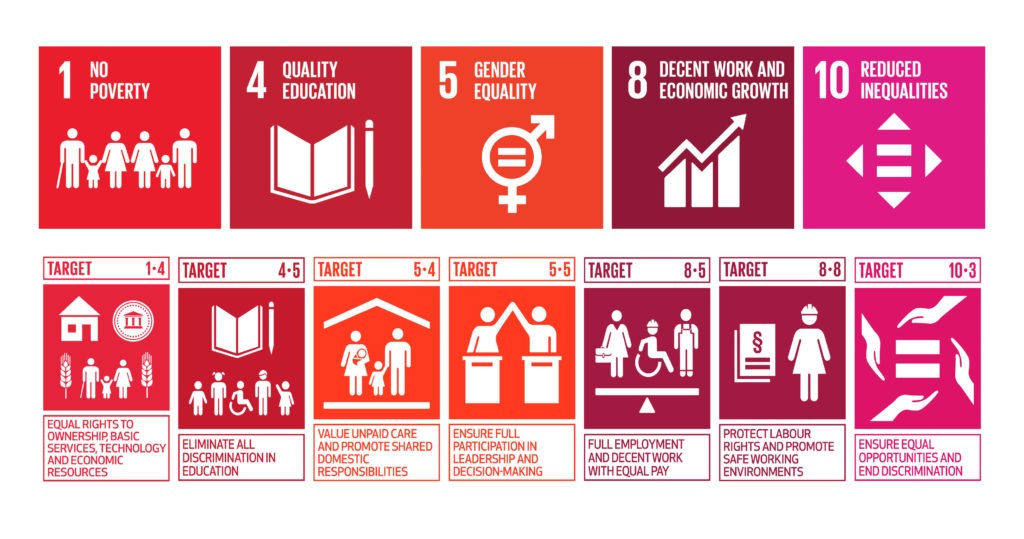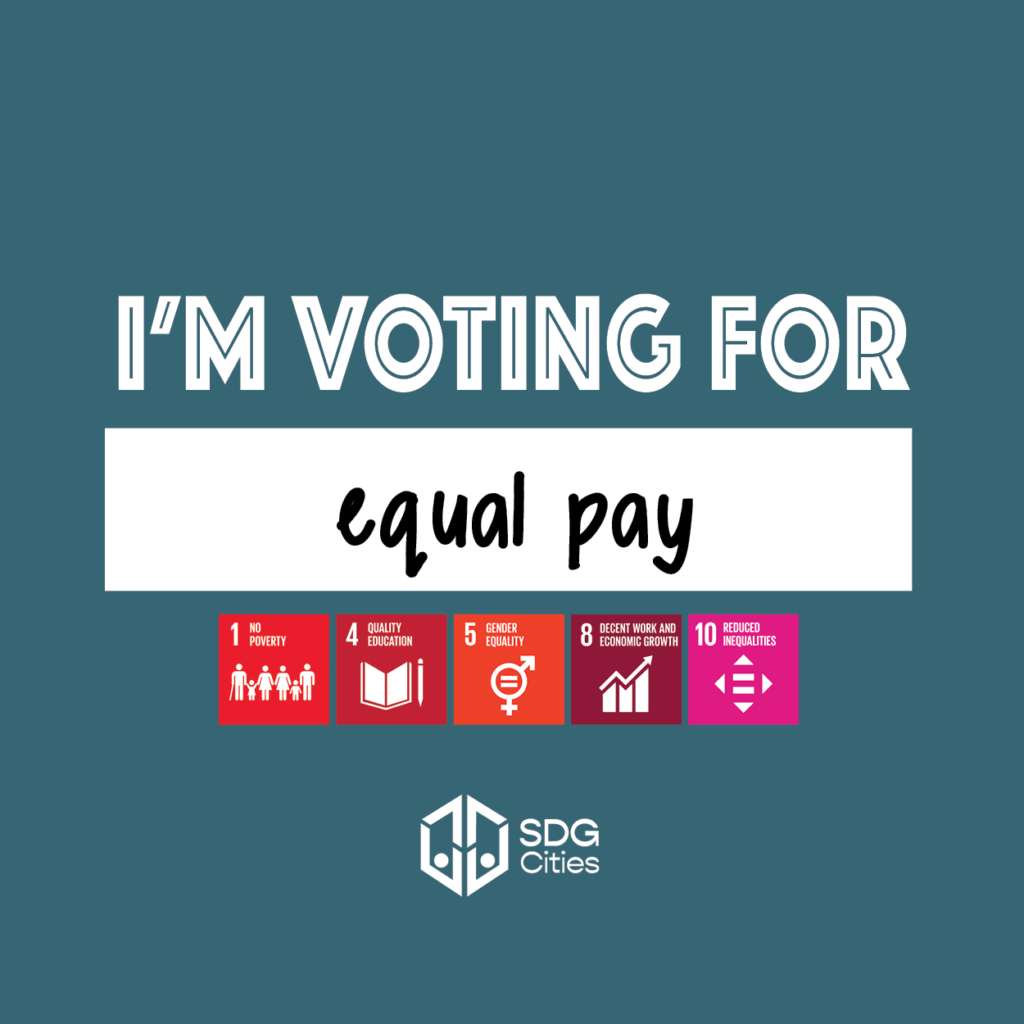Vote 4 the SDGs: Equal Pay
The UN Sustainable Development Goals (SDGs) are universal, target oriented and interconnected. They provide clear objectives that can help us hold our governments and elected officials accountable, measure progress and act as a common language as we work for change across sectors. This Vote 4 the SDGs series aims to engage community members about important issues and situate them within the SDG framework. We aim to promote productive conversations about the issues that matter – and help inspire solutions for a just and sustainable future for all.
Are you voting for equal pay?
April 12, 2022 is #EqualPayDay in Ontario. For the first time ever, provincial party leaders will debate women’s issues and discuss what it will take to close the gender pay gap in Ontario. Click here to register for the livestream event.
Voting for equal pay, means voting for a future where women and gender diverse people across Ontario can access the resources and opportunities they need to fully participate in and contribute to the economic, political, and cultural life of their community and province.
Relevant goals and targets from the UN Sustainable Development Goals (SDGs)

What is the gender pay gap?
The gender pay gap refers to the difference in average earnings of people based on gender (Source). Canadian Income Survey data puts the gender pay gap at 30% in Ontario (based on annual average earnings). There are a number of ways that the gender pay gap is calculated in Canada. The Ontario Equal Pay Coalition uses annual average earnings as the best representation of women’s economic inequality. This calculation considers:
- The underemployment of women and prevalence of precarious work.
- Lack of access to affordable childcare for women who want full-time work.
- The segregation of women into lower paid job classes.
- Women’s dominance in minimum wage jobs.
- Women’s lack of access to collective bargaining.
For individuals who face multiple barriers, the gender pay gap is even worse (Source). For women with disabilities, that gender pay gap is 56%, nearly twice that of the overall population. For immigrant women the gap is 55%, for Indigenous women the gap is 45% and for racialized women the gap is 40%. The pay gap also affects women across their working life. Girls 12-18 experience a pay gap of $3 at their summer jobs (Source), while women retire with about 80% of the pension of men (Source).
Women also make up the majority of workers in precarious employment and predominate lower paying occupations (Source). 56% of women in the workforce are concentrated in occupations known at the 5Cs: caring, cashiering, catering, cleaning and clerical functions (Source). During the Covid-19 pandemic, workers in these sectors were considered “essential” yet few protections and benefits were provided.
Women represented two thirds (63%) of all job losses in March 2020 at the onset of the Covid-19 pandemic, despite comprising less than half (47%) of the working population (Source). Women entrepreneurs also face significant barriers to accessing financing and other business development support. The pandemic led to a dramatic decrease in funding for women-led businesses (Source).
What will it take to close the gender pay gap?
The gender pay gap is a significant social and economic problem in Ontario and across Canada. The pandemic further exacerbated the issue – pushing women, and gender diverse individuals further behind. Voting for equal pay means supporting policies that invest in and empower women, especially those women who face additional barriers such as racialized women, Indigenous women and women with disabilities. Policies must also provide services and support to working families and reduce economic inequality across the population.
The Equal Pay Coalition highlights five important policy actions that would help close the gender pay gap in Ontario.
- Increase to the minimum wage. Increasing the minimum wage would directly support women working in low paying sectors. A current proposal will bring the minimum wage to $15.50/hour by October 2022. With this increase minimum wage is still well below the living wage across Ontario (Source). For example, in Guelph-Wellington, the living wage is currently calculated at $18.10/hour.
- Mandating paid sick days for workers. During the pandemic the lack of paid sick leave for workers caused many challenges. The pandemic did lead to some changes. In 2022, BC introduced 5 paid sick days and workers in federally regulated workplaces across Canada may soon be entitled to 10 paid sick days. Despite the critical need identified by the pandemic – paid sick day policies are not wide spread.
- Implementing the Pay Transparency Act. Ontario passed the Pay Transparency Act in 2018 requiring employers with 100+ employees to make annual reports on gender pay equality.
- Establishing affordable, accessible public childcare with decent wages and conditions for childcare workers. New legislation recently signed by the Ontario government would see $10 a day childcare available by September 2025.
- Rebuilding the economy by funding public services and providing health, community & social services, and education workers with decent wages and working conditions.
The Equal Pay Coalition has also published a 12 Step Plan for closing the gap for policy-makers and employers.
Recommendations from the YWCA Feminist Economic Recovery Plan call for direct investment in communities hardest hit by the pandemic, including:
- Targeted support to business owners from underrepresented groups including racialized people, persons with disabilities, Indigenous people, and immigrants—in the form of emergency funding, as well as skills training and mentorship.
- Direct funding to businesses in women majority sectors hard hit by the pandemic such as caregiving and social enterprises. This plan recognizes “There is no recovery if we leave women, Two-Spirit, and gender-diverse people behind.”
Read the full set of recommendations for an inclusive economic recovery that addressed the needs of women, Two-spirited and gender diverse people.
Resources
The Canadian Women’s Foundation. The Facts about the Gender Pay Gap. https://canadianwomen.org/the-facts/the-gender-pay-gap/
The Equal Pay Coalition. Calculating the Pay Gap. http://equalpaycoalition.org/calculating-the-pay-gap/
Moyser, M. Measuring and Analyzing the Gender Pay Gap: A Conceptual and Methodological Overview. Statistics Canada. https://www150.statcan.gc.ca/n1/pub/45-20-0002/452000022019001-eng.htm
Girl Guides of Canada. 2019. Girls on the Job: Realities in Canada. https://www.girlguides.ca/WEB/Documents/GGC/media/thought-leadership/girlsonjob/GirlsOnTheJobRealitiesInCanada.pdf
Mercer, CFA Index. Global Pension Report 2021. https://www.mercer.com/our-thinking/global-pension-index-2021.html
Cornish, M. 2016. Every Step You Take: Ontario’s Gender Pay Gap Ladder. Canadian Centre for Policy Alternatives. www.policyalternatives.ca/publications/reports/ontario
Scott, K. March 20, 2020. COVID-19 crisis response must address gender faultlines. The Monitor. https://monitormag.ca/articles/covid-19-crisis-response-must-address-gender-faultlines/
Teare, G. December 21, 2020. Global VC Funding To Female Founders Dropped Dramatically This Year. https://news.crunchbase.com/news/global-vc-funding-to-female-founders/
Ontario Living Wage Coalition. Living Wage by Region. https://www.ontariolivingwage.ca/living_wage_by_region
Equal Pay Coalition. 12 Steps to Closing the Gap. http://equalpaycoalition.org/12-steps-to-closing-the-gap/
YWCA. 2021. A Femanist Economic Recovery Plan. https://www.feministrecovery.ca/

